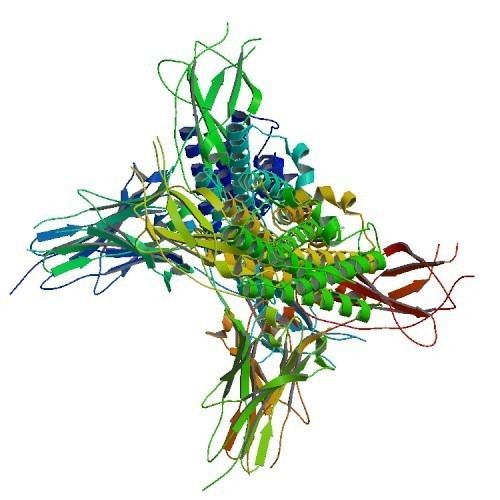AHFS/Drugs.com Monograph Routes ofadministration IV, subQ CAS Number 143011-72-7 | Pregnancycategory C ATC code L03AA02 (WHO) Molar mass 18,802.8 g/mol | |
 | ||
Trade names Neupogen, Zarxio, others | ||
Filgrastim, sold under the brand name Neupogen among others, is a medication used to treat low blood neutrophils due to a number of causes. This includes when it occurs following chemotherapy, radiation poisoning, HIV/AIDS, or is of unknown cause. It may also be used to increase white blood cells for gathering during leukapheresis. It is given either by injection into a vein or under the skin.
Contents
- Medical uses
- Adverse effects
- Interactions
- Mechanism of action
- Production
- Commercialization
- Biosimilar
- References
Common side effects include fever, cough, chest pain, joint pain, vomiting, and hair loss. Severe side effects include splenic rupture and allergic reactions. It is unclear if use in pregnancy is safe for the baby. Filgrastim is similar to naturally occurring granulocyte colony-stimulating factor (G-CSF).
Filgrastim was approved for medical use in the United States in 1991. It is on the World Health Organization's List of Essential Medicines, the most effective and safe medicines needed in a health system. The wholesale cost in the developing world is about 3.95 to 94.66 USD per dose. In the United Kingdom it cost the NIH about 50.15 pounds per 300 ug dose. In the United States treatment costs more than 200 USD. Biosimilars are available.
Medical uses
Filgrastim is used to treat neutropenia, stimulating the bone marrow to increase production of neutrophils. Causes of neutropenia include chemotherapy and bone marrow transplantation.
Filgrastim is also used to increase the number of hematopoietic stem cells in the blood before collection by leukapheresis for use in hematopoietic stem cell transplantation.
Adverse effects
The most commonly observed adverse effect is mild bone pain after repeated administration and local skin reactions at the site of injection. Other observed adverse effects include serious allergic reactions (including a rash over the whole body, shortness of breath, wheezing, dizziness, swelling around the mouth or eyes, fast pulse, and sweating), ruptured spleen (sometimes resulting in death), alveolar hemorrhage, acute respiratory distress syndrome, and hemoptysis. Severe sickle cell crises, in some cases resulting in death, have been associated with the use of filgrastim in patients with sickle cell disorders.
Interactions
Drug interactions between filgrastim and other drugs have not been fully evaluated. Drugs which may potentiate the release of neutrophils‚ such as lithium‚ should be used with caution.
Increased hematopoietic activity of the bone marrow in response to growth factor therapy has been associated with transient positive bone imaging changes; this should be considered when interpreting bone-imaging results.
Filgrastim has not been studied in pregnant women and its effects on the fetus is unknown. If taking filgrastim while pregnant, it is possible that traces of the drug could be found in the baby's blood. It is not known if the drug can get into human breast milk.
Mechanism of action
Filgrastim is a human granulocyte colony stimulating factor (G-CSF) produced by recombinant DNA technology. G-CSF regulates the production of neutrophils within the bone marrow; endogenous G-CSF is a glycoprotein produced by monocytes, fibroblasts, and endothelial cells.
G-CSF is a colony stimulating factor which has been shown to have minimal direct in vivo or in vitro effects on the production of other haematopoietic cell types. NEUPOGEN (filgrastim) is the name for recombinant methionyl human granulocyte colony stimulating factor (r-metHuG-CSF).
Production
It is produced by recombinant DNA technology. The gene for human granulocyte colony-stimulating factor is inserted into the genetic material of Escherichia coli. The G-CSF then produced by E. coli is different from G-CSF naturally made in humans.
Commercialization
Filgrastim is marketed under several brand names, including:
Apricus Biosciences is currently developing and testing a product under the brand name Nupen which can deliver filgrastim through the skin to improve post-chemotherapy recovery of neutrophil counts.
Biosimilar
In 2015, Sandoz’s filgrastim-sndz (trade name Zarxio), obtained the FDA's approval as a biosimilar. This is the first product to be passed under the Biologics Price Competition and Innovation Act of 2009 (BPCI Act), as part of President Obama's March 2010 Affordable Care Act. Zarxio was approved as a biosimilar, not as an interchangeable product, the FDA notes. And under the BPCI Act, only a biologic that has been approved as an “interchangeable” may be substituted for the reference product without the intervention of the health care provider who prescribed the reference product. The FDA said its approval of Zarxio is based on review of evidence that included structural and functional characterization, animal study data, human pharmacokinetic and pharmacodynamics data, clinical immunogenicity data and other clinical safety and effectiveness data that demonstrates Zarxio is biosimilar to Neupogen.
Zarxio is approved for the same indications as Neupogen, and can be prescribed by a health care professional for: patients with cancer receiving myelosuppressive chemotherapy; patients with acute myeloid leukemia receiving induction or consolidation chemotherapy; patients with cancer undergoing bone marrow transplantation; patients undergoing autologous peripheral blood progenitor cell collection and therapy; and patients with severe chronic neutropenia.
